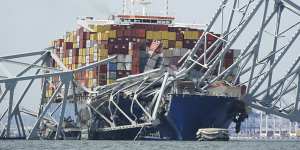The revelation came as the bodies of two of the victims were discovered by divers in a ute submerged in the Patapsco River,about 32 hours after they plunged to their deaths.
Investigators have also retrieved a voyage recorder from the ship with six hours of data and have begun interviewing the 21 crew members and two pilots who were still on board the vessel,in a bid to uncover what led to the tragic collision.

A Coast Guard cutter passes the Dali cargo ship stuck under the destroyed Francis Scott Key Bridge.AP
National Transportation Safety Board chair Jennifer Homendy said the data recordings would provide a crucial timeline of what happened in the moments before the crash.
This includes three terrifying minutes in which the ship began to veer out of control,prompting the pilot to call for nearby tugboats to help,before ordering the anchor to drop because the ship had lost power and was barrelling towards the Francis Scott Key Bridge.
She revealed the bridge was only in “satisfactory condition” and was “fracture critical”,meaning that if one of its pylons came down,the whole structure would fall because it had not been built to withstand such impact.
“We’re very sorry for all that you are going through,” Homendy said,as she expressed her condolences to the families of the victims. “It’s unimaginable.”
The comments came as the bodies of two of six missing workers were discovered by divers just before 10am Wednesday (Baltimore time),in a red ute submerged in about eight metres of water. They were identified as Alejandro Hernandez Fuentes,35,and Dorlian Castillo Cabrera,26.
Another man who is presumed dead has been identified by his brother as Maynor Yassir Suazo Sandoval,a Baltimore father who came to the US from Honduras in 2003.
Father of three Miguel Luna,a local resident originally from El Salvador,was also identified by non-profit organisation Casa,which provides services to immigrant communities,and later by his wife in an interview with Spanish network Telemundo.

Maynor Yassir Suazo Sandoval,one of the maintenance crew presumed dead after the Baltimore bridge collapse.AP
“Our hearts ache for the families of the victims and all those impacted by this horrific accident,” said the group’s executive director Gustavo Torres.
Most of the workers were employed by Maryland construction contractor Brawner Builders. Two of them were rescued soon after the crash,but dozens of divers braved treacherous weather conditions the next day to find the others beneath the twisted metal that was once one of Baltimore’s most iconic bridges.
As for the ship,Vice Admiral Peter Gautier,the US Coast Guard deputy commandant for operations,said it remained stable in the waters of the Patapsco,but had more than 1.5 million gallons of fuel and lubricant oil on board.
The ship was undergoing “routine engine maintenance” in the port before the incident but authorities were not informed of any problems.
Fifty-six of the 4700 cargo containers on board the ship,known as Dali,contain hazardous materials,Gautier said,and two cargo containers with non-hazardous material were missing overboard.

As the recovery continues,attention also shifted to the economic impact of the crash,which experts fear could cost up to $US15 million ($23 million) for each day the Port of Baltimore is closed.
The port is a major employer in the US,providing more than 15,000 direct jobs and almost 140,000 indirect jobs. It is also used by companies such as Amazon,Ford and Domino Sugar,whose Baltimore refinery is the biggest in the western hemisphere.
About 14 ships are stuck in the port,while the loss of the bridge has knocked out a major thoroughfare,not just for the blue-collar communities at each end of it,but also for millions of Americans who used the bridge en route from Washington DC and Maryland,to states such as New York and Delaware.

Carlos Suazo Sandoval speaks with a reporter on the phone about his younger brother,Maynor Yassir Suazo Sandoval,who was working on the bridge at the time of its collapse.AP
Tinglong Dai,a professor at the Johns Hopkins Carey Business School,said the port played “a very big role” in the local,regional and national economies. But he believed the supply chain was resilient enough to cope as some cargo was already being re-routed to other ports across the US.
“The Port of Baltimore is not among the largest port in the United States,let alone in the world,but it’s niche,or very specialised,especially in automobile and truck imports and exports,” he said.
“We’re going to see more re-routing happening in the coming months,if not the coming year,so I would expect the impact to be relatively local and short term.”
Tuesday’s collision took place shortly after the Dali left for what was meant to be a 27-day journey to Sri Lanka.
As it approached the bridge,it lost propulsion and was unable to slow down. A mayday was issued – which allowed authorities to stop traffic from entering – but the maintenance workers had no time to evacuate. Eight fell into the Patapsco River as the bridge crumpled on impact.

Baltimore continues to process the tragedy. At the Mt Olive Baptist Church,government officials and faith leaders held a vigil to honour the victims and pledge support for their families.
On one of the main highways connecting the city to Washington DC,a billboard for first responders proudly declares:“Thank you for responding at Key Bridge.”
And across the city,residents remain stunned by the loss of what was an iconic fixture in the skyline for almost half a century.
“It was just a shocking way to wake up yesterday morning,” said Rachel Sangree,an academic.
“This is an iconic Baltimore structure that I’ve seen every day in the 20-plus years I’ve lived in the area.”
Get a note directly from our foreigncorrespondentson what’s making headlines around the world..